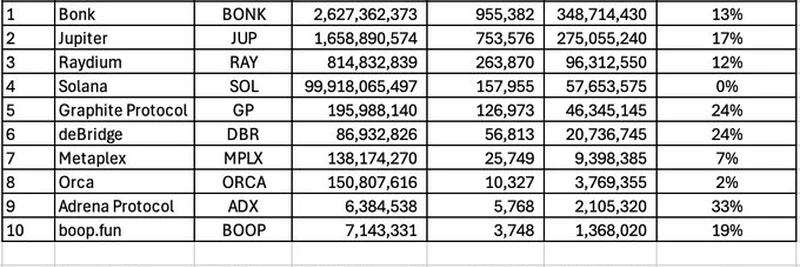If you're a blockchain enthusiast or a meme token investor, you’ve probably noticed the buzz around recent data shared by travelfrog2k on X. This thread dives deep into the world of meme tokens, using data from DefiLlama and CoinGecko to analyze how much value these projects return to their holders. Let’s break it down and see what this means for your investment strategy!
What’s the Data All About?
The thread features a detailed table ranking various meme tokens by market cap (MCAP), 24-hour revenue, annual revenue, and the percentage of market cap returned to holders annually (Annual Rev/MCAP). For example, top tokens like Bonk (BONK) and Jupiter (JUP) show impressive returns of 13% and 17% respectively. But the real standout? Graphite Protocol (GP) with a whopping 24% return, compared to Hyperliquid HYPE’s modest 5%.
This metric—Annual Rev/MCAP—is a key indicator. It shows how much of a token’s market value is redistributed to holders each year through revenue. A higher percentage means more value is flowing back to you, the investor. For context, travelfrog2k highlights that to match HYPE’s 5% return, GP would need to grow its market cap by 4.7x, pushing its price to around $29.89. That’s a bold prediction!
Spotlight on Graphite Protocol and Hyperliquid HYPE
Let’s zoom in on the two tokens mentioned in the thread:
Graphite Protocol (GP): With a 24% Annual Rev/MCAP, GP is a leader in returning value to holders. The data suggests this project is efficiently distributing 24% of its market cap back annually, which could be a green flag for investors looking for high-yield opportunities. The thread’s second image hints at how this revenue is generated—possibly through fees or staking rewards—making it a project worth watching.
Hyperliquid HYPE: Sitting at 5%, HYPE offers a more conservative return. With a massive market cap of $14.6 billion and an annual revenue of $737 million, it’s clear this token operates on a larger scale. However, its lower percentage suggests less aggressive redistribution, which might appeal to those seeking stability over high returns.
Why This Matters for Meme Token Investors
Meme tokens are often seen as fun, speculative investments, but this data shifts the narrative. Projects like GP show that some meme tokens can offer substantial returns, blending the excitement of memes with real financial incentives. On the flip side, HYPE’s lower yield might indicate a focus on long-term growth rather than immediate payouts.
If you’re diving into this space, consider what aligns with your goals. Are you chasing high returns like GP’s 24%, or do you prefer the steady vibe of HYPE’s 5%? The thread also mentions other tokens like Adrena Protocol (33%) and boop.fun (19%), showing a wide range of opportunities across the board.
Final Thoughts
This analysis from travelfrog2k opens up a fascinating discussion about meme token economics. Whether you’re a seasoned blockchain practitioner or just getting started, understanding these metrics can help you make smarter choices. Keep an eye on GP’s potential 4.7x growth or HYPE’s massive scale—both could shape the future of your portfolio.
Got questions or want to dig deeper? Drop a comment below or check out more insights on meme-insider.com. Happy investing!


